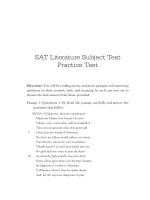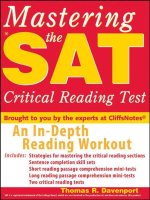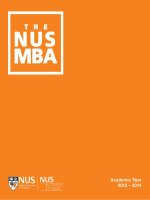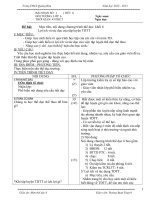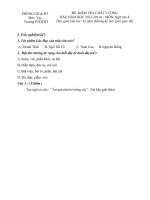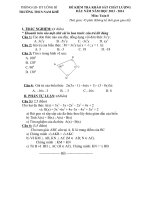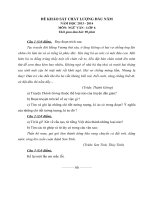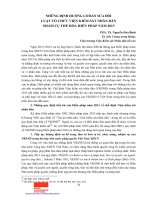Cracking the SAT literature subject test, 2013 2014 edition princeton review
Bạn đang xem bản rút gọn của tài liệu. Xem và tải ngay bản đầy đủ của tài liệu tại đây (3.91 MB, 312 trang )
Editorial
Rob Franek, Senior VP, Publisher
Mary Beth Garrick, Director of Production
Selena Coppock, Senior Editor
Calvin Cato, Editor
Kristen O’Toole, Editor
Meave Shelton, Editor
Random House Publishing Team
Tom Russell, Publisher
Nicole Benhabib, Publishing Director
Ellen L. Reed, Production Manager
Alison Stoltzfus, Managing Editor
The Princeton Review, Inc.
111 Speen Street, Suite 550
Framingham, MA 01701
E-mail:
Copyright © 2013 by TPR Education IP Holdings, LLC.
Cover art © Jonathan Pozniak
All rights reserved under International and Pan-American Copyright Conventions. Published in the United States by Random
House, Inc., New York, and simultaneously in Canada by Random House of Canada Limited, Toronto.
Excerpt from The Last Report on the Miracles at Little No Horse reprinted by permission of HarperCollins Publishers Inc.
Copyright © 2001 by Louise Erdrich.
Excerpt from Waiting reprinted by permission of Pantheon Books, a division of Random House, Inc. Copyright © 1999 by Ha
Jin.
“Brass Spittoons” reprinted by permission of Harold Ober Associates Incorporated. Copyright © 1927 by Alfred A. Knopf.,
Inc. Copyright renewed 1955 by Langston Hughes.
“There Is No Frigate Like a Book” reprinted from The Complete Poems of Emily Dickinson, edited by Thomas H. Johnson,
by permission of Little, Brown and Company.
“Blue Girls” copyright 1927 by Alfred A. Knopf, Inc. and renewed 1955 by John Crowe Ransom. Reprinted from Selected
Poems, Third Edition, Revised and Enlarged by John Crowe Ransom, by permission of Alfred A. Knopf, Inc.
“Madman’s Song” copyright 1921 by Alfred A. Knopf, Inc. and renewed 1949 by William Rose Benét. Reprinted by
permission of Alfred A. Knopf, Inc.
“Of Studies” reprinted from Seventeenth-Century Prose and Poetry, 2nd ed., edited by Alexander M. Witherspoon and Frank
J. Warnke, by permission of Harcourt Brace and Company.
“The Mower to the Glowworms” reprinted from Seventeenth-Century Prose and Poetry, 2nd ed., edited by Alexander M.
Witherspoon and Frank J. Warnke, by permission of Harcourt Brace and Company.
“Promises Like Pie-crust” by Christina Rossetti reprinted from Poems and Prose, edited by Jan Marsh, by permission of J.
M. Dent.
“The Shoemakers’ Holiday” by Thomas Dekker reprinted from Early Seventeenth Century Dramas, edited by Robert G.
Lawrence, by permission of J. M. Dent.
“The Supper at Elsinore” reprinted from Seven Gothic Tales, by Isak Dinesen, by permission of the Rungstedlund
Foundation.
eBook ISBN: 978-0-307-94573-0
Trade Paperback ISBN: 978-0-307-94553-2
SAT is a registered trademark of the College Board.
The Princeton Review is not affiliated with Princeton University.
Editor: Liz Rutzel
Production Editor: Koty Zelinka
Production Artist: John E. Stecyk
2013–2014 Edition
v3.1
Acknowledgments
I would like to thank the following people who assisted in the writing of this book: Suzanne
Markert, Christine Parker, Lisa Liberati, Liz Buffa, and the New York City Public Library.
A special thanks to Adam Robinson, who conceived of and perfected the Joe Bloggs
approach to standardized tests and many of the other successful techniques used by The
Princeton Review.
Contents
Cover
Title Page
Copyright
Acknowledgments
Part I: Overview
1
2
The Route to College
Approaching the SAT Subject Tests
Part II: Cracking the SAT Literature Subject Test
3
4
5
6
7
8
9
Overview
Test Strategies
Test Strategies for the SAT Literature Subject Test
Terms—The Only Stuff You Need to Know
Analyzing Prose
Poetry Doesn’t Bite
Drama Queens
(and Kings and Princes and the Occasional Duchess)
10 Final Thoughts
11 Answers and Explanations to Drills
Part III: The Princeton Review Practice SAT
Literature Subject Tests
12
13
14
15
16
17
18
19
20
How to Take the Practice SAT Literature Subject Tests
Practice Test 1
Practice Test 1: Answers and Explanations
Practice Test 2
Practice Test 2: Answers and Explanations
Practice Test 3
Practice Test 3: Answers and Explanations
Practice Test 4
Practice Test 4: Answers and Explanations
About the Author
Part I
Overview
1
2
The Route to College
Approaching the SAT Subject Tests
Chapter 1
The Route to College
WHERE DO STANDARDIZED TESTS COME FROM?
If you’ve purchased this book, you are probably preparing to apply to college. Part of
the long and arduous college admissions process will almost certainly include some
standardized tests. For most of you, these tests will come from a company called the
College Board. This company has hired the Educational Testing Service, or ETS, to
administer and grade its exams.
WHAT IS THE PRINCETON REVIEW?
The Princeton Review is a test-preparation company. We have branches all over the
United States and abroad. We’ve developed the techniques you’ll nd our books, courses,
and online resources by analyzing several years’ worth of actual exams. We’ve seen the
effectiveness of our techniques in action with thousands of our students.
Tick Tock
We don’t waste your time.
We tell you what you
need to know and, more
importantly, what you
don’t need to know.
Our approach is what makes our techniques unique. We base our principles on those
used by the people who write the test. We don’t want to waste your time with
information that you don’t need to know. We know you’re busy. We’re not going to
teach you “How to Appreciate Fine English Literature” (although that’s a wonderful
thing to know), but rather the information you’ll need to get great score improvements
on this test. You’ll learn to recognize and comprehend the relatively small amount of
information that’s actually tested. You’ll also learn to avoid common traps, to think like
the test writers, to find answers to challenging questions.
You need to do only three things: trust the techniques, practice them, and then practice
some more.
WHAT IS THE SAT?
The SAT is a three-hour-and-forty- ve-minute, multiple-choice exam used by colleges to
provide a standard measure of high school students around the country. There are three
separate scores generated by the SAT: a critical reading score (on a scale of 200–800), a
writing score (on a scale of 200–800, which combines separate essay and grammar
scores), and a math score (also on a 200–800 scale).
Not an IQ Test
The SAT is not a measure
of your intelligence. It is a
measure only of your
ability to take a
standardized test.
What Does the SAT Measure?
Precious little: some vocabulary, some reading skills, some grammar, some basic math.
What it’s designed to measure—taken in context with your high school grades—is what
your college grades will be. Primarily, it measures your ability to take standardized
tests.
What Are the SAT Subject Tests?
These are a series of one-hour exams administered by ETS. Unlike the SAT, the SAT
Subject Tests are designed to measure speci c knowledge in speci c areas. There are
tests in many subject areas, such as biology, history, French, and math. They are each
scored separately on the familiar 200–800 scale.
Should I Take the SAT Subject Tests?
According to the College Board (which, since it sells you the tests, really has an interest
in in ating these numbers) only 160 institutions require or recommend that you take
(usually two) SAT Subject Tests. Of course, these are widely considered to be the most
selective institutions in the nation. Many schools will waive the requirement if a student
takes the ACT with writing in lieu of the SAT Reasoning test. If you are applying to an
engineering program, you will usually be asked to take two tests: Math (generally level
2) and a science (you usually have the option of Chemistry or Physics). Your rst order
of business is to visit the websites of the colleges you’re interested in, which have the
most up-to-date information about their individual policies.
How Are the SAT Subject Tests Used by College Admissions?
Since the University of California stopped requiring two SAT Subject Tests for
admission, there’s almost no data publicly available. Engineering programs tend to nd
subject test scores a more reliable indicator of a future student’s performance than the
SAT Reasoning Test, so they take the scores very seriously. At the other end of the
spectrum are schools that ignore the scores altogether in the admissions process, and
simply use them for placement purposes (usually in foreign language and math) when a
student arrives on campus. To nd out exactly how the colleges you are considering will
use the scores, visit their websites, or contact their admissions o ces via phone or email.
SAT Subject Tests are not just used for college admission and placement. For example, if
you live in New York State, you may be able to use SAT Subject Test scores to substitute
for a Regents examination score. Speak with your counselor or teacher to see if this
might be appropriate for you. In addition, some colleges allow you to use SAT Subject
Test scores to meet minimum subject-based requirements to be eligible to apply for
admission (e.g., University of California’s a-g requirements, Arizona State University’s
subject competency requirements).
Score Choice is Back!
Since February 2009, you have been able to choose which SAT Subject Test scores you
want colleges to see. This is great news! For one thing, if you take more than one SAT
Subject Test on a given test date, you’ll be able to choose which tests from that date
you’d like to submit to colleges. So if, for example, you take the French test followed by
the Chemistry test, but don’t think the Chemistry test went very well, you can simply opt
to have that Chemistry score withheld from the schools to which you are applying.
However, before you start testing haphazardly, remember that many colleges request
that you submit your entire testing record. (Again, contact the speci c colleges that
interest you—policies are constantly changing.) You are on the honor system to submit
your full record, but we advise that you provide colleges the information they request.
The new score reporting policy, as it’s being called, will be optional for students. This
means that you aren’t required to opt in and actively choose which speci c scores you
would like sent to colleges. If you decide not to use the new score-reporting feature,
then all of the scores on file will automatically be sent when you request score reports.
For more information about the new score-reporting policy, go to the College Board
website at www.collegeboard.com.
Chapter 2
Approaching the SAT Subject Tests
Which Test(s) Should I Take? When?
Which test(s) should you take? The answer is simple:
• the tests that are required by the colleges to which you are applying
• the SAT Subject Tests that you will do well on
Some colleges have speci c requirements; others do not. Again, start asking questions
before you start taking tests. That means you should check with the school’s admissions
o ce or website. College guidebooks, catalogs, and guidance counselors should also
have this information. Once you nd out which, if any, tests are required, part of your
decision making is done.
The next step is to nd out which of the tests will show your particular strengths.
Generally (although, again, check with the colleges you want to apply to) colleges will
require (or will “strongly suggest”) two SAT Subject Tests: usually Math Level 1 or 2 and
something else.
Subject tests are given in the following areas: literature, U.S. history, world history,
biology, chemistry, physics, math, and a variety of foreign languages.
An Offer You
Can’t Refuse
Some schools will
“strongly suggest” that
you take certain tests. It’s
wise to follow their
suggestions, as they are the
ones who will ultimately
be judging your
application for admission.
Your number one concern is to determine which tests you will score well on. Then you
will want to think about the purposes for which the test will be used. If you plan to
major in biology, you should probably take the biology test. If you’re a whiz at
anything, take that test (no, there is no test in video games, or pancake eating, or
marathon sleeping).
After you’ve checked your requirements and examined your needs, take a diagnostic test
like the ones at the end of this book. See how you do, and with that in mind, determine
whether the test is for you.
Try to take the tests as close as possible to the completion of the corresponding
coursework you are taking. If you plan to take the SAT Chemistry Subject Test, for
example, and you are currently taking high school chemistry, don’t postpone the test
until next year. Take it while the information is still fresh. (Are you really going to study
over the summer? Come on. Really?)
When Are the SAT Subject Tests Offered?
In general, you can take from one to three SAT Subject Tests per test date in October,
November, December, January, May, and June at test sites across the country. Check the
dates carefully, as not all subjects are o ered at each administration. You’ll want to sit
down with a calendar and plan, as there are limited dates and a lot of tests to take. For
instance, you may want to retake the SATs on one of those days, or you may want to
apply early to a school and have all your scores before your application is due in early
fall. Register for the test early so you get the location you want.
SAT Subject Tests are o ered in January, May, June, October, November, and
December.
Should I Take the SAT Literature Subject Test?
The SAT Literature Subject Test will test your knowledge of basic literary terms and your
ability to understand selected literary passages (prose, poetry, and drama) written in
English. You don’t have to know speci cs about literature originally written in English
to do well on the test.
To a Point
Bring only a pencil: You
need NO outside
knowledge of literature!
If you’re unsure about whether you should take this test, start perusing college catalogs
or contact the college(s) you will probably be applying to. Admissions o ces should be
able to tell you if this test is necessary.
If you feel con dent about your ability to analyze and interpret literature, are a good
reader, do well in English class, or plan to major in English in college, consider taking
the SAT Literature Subject Test.
Registration
The easiest way to register is via the Internet www.collegeboard.com (you’ll need a
credit card). This site contains other useful information such as the test dates and fees.
You can also register by mail (remember regular mail?) by picking up a registration
form and Student Bulletin at your guidance counselor’s o ce. If you have any questions,
call 866-756-7346. If you need to register for extended time or make special
arrangements due to learning di erences or disabilities, you can speak with a
representative at the College Board by calling 609-771-7137. Start this process early, as
the paperwork is fairly extensive.
On test day, you can take a single one-hour test and leave or take two or three di erent
one-hour tests. You may have the scores sent to you, your school, and up to four colleges
of your choice. Additional reports can be sent to additional colleges for, yup, additional
money. The scores are usually posted online two weeks after the test date and are
mailed two weeks later (although they can take up to six weeks to arrive).
What’s a Good Score?
Very few colleges release any data regarding how they use subject tests in admissions.
Additionally, since such a wide range of subject tests is available, your score can only be
compared with students who took the same subject test.
What’s important to schools is your percentile ranking (which will be sent along with
your scores). This number tells colleges how you you scored relative to other test-takers
who took the same test over a longer period of time (not just the day you took the test).
In other words, a percentile rank of 60 means that 40 percent of test takers scored
above you and 60 percent of test takers scored below you.
The mean on the SAT Literature Subject Test—and on most SAT Subject Tests—is 600.
Is Any Other Material Available for Practice?
The College Board publishes a book called O cial Study Guide for All SAT Subject Tests,
which contains full-length tests for almost all of the SAT Subject Tests o ered. You can
also go to the College Board’s website, www.collegeboard.com for more information and
practice questions.
For book updates and more information, visit PrincetonReview.com.
Part II
Cracking the SAT Literature Subject Test
3
4
5
6
7
8
9
10
11
Overview
Test Strategies
Test Strategies for the SAT Literature Subject Test
Terms—The Only Stuff You Need to Know
Analyzing Prose
Poetry Doesn’t Bite
Drama Queens (and Kings and Princes and the Occasional Duchess)
Final Thoughts
Answers and Explanations to Drills
Chapter 3
Overview
In this chapter, you’ll learn what the SAT Literature Subject Test comprises and how it’s
scored. We will tell you how best to use this book and what you can expect from the
test.
WHAT DOES THE TEST LOOK LIKE?
You’ll have one hour to answer 60 to 63 multiple-choice questions. You will read six to
eight passages (usually seven), each followed by a series of multiple-choice questions.
The content will be varied: prose ction, autobiography, personal essays, excerpts from
speeches, poetry, and drama. You may be asked to compare two passages.
What Is Tested on the SAT Literature Subject Test?
All SAT Subject Tests are only one hour long, so it’s impossible to test a broad range of
topics in so short a time. As a result, the SAT Literature Subject Test is relatively easy to
prepare for.
You will be asked to interpret certain excerpts from literature. You will need to be
familiar with some of the basic literary terms your teachers have been tossing around in
your English classes all these years: Common terms such as metaphor, tone, and imagery
will be covered; obscure terms such as enjambment and metonymy will not.
It’s All in the Technique
To crack the SAT
Literature Subject Test,
you need to do two things:
First, become familiar
with some basic literary
terms; second, learn some
techniques for analyzing a
literary passage.
DO NOT sit down with a reading list and a dictionary of literary terms (at least, not to
prepare for this test). Instead, concentrate on pinning down literary terms that sound
vaguely familiar and learning some great techniques for analyzing the types of passages
that will be on the exam.
What the SAT Literature Subject Test Doesn’t Test
The good news: You’re not expected to be familiar with any speci c works of literature;
in fact, the test writers try hard to make sure they provide pieces that few students will
have read. There’s no o cial reading list for the SAT Literature Subject Test. You won’t
be asked who the author is, when the piece was written (the year of publication is
provided to you), or where the piece ts within the history of literature. This is simply a
one-hour test of your ability to read and comprehend literature and of your familiarity
with basic literary terms.
How to Use This Book
We recommend three simple steps to prepare for the SAT Literature Subject Test.
• Start early. The key to cracking the test is practice. Practicing for six hours the day
before the test won’t do a whole lot of good (and may fry your brain). Instead, give
yourself plenty of time to read this book thoroughly.
• Read this book in order. Inside, you’ll find an overview of the information you need
to know to get a great score on the test. Terms and techniques are explained, and
there are drills and practice questions that ask you to apply them. Each technique
builds on a skill we’ve previously taught you.
• Trust us. We’ve been in the business for a long time. Some of the techniques may be
new to you. They might feel unfamiliar at first, but with practice they will become
easier. They may even contradict some things you’ve learned in English class.
Remember that English class is designed to educate you. This book is designed to
help you do well on a specific test.
HOW THE TEST IS STRUCTURED
The SAT Literature Subject Test consists of about 60 to 63 multiple-choice questions (the
speci c number varies on each test). Each of the six to eight passages of prose, poetry,
or drama is followed by 4 to 12 questions. Most of the passages come from English and
American literature. On occasion, you’ll see a passage from another English-speaking
culture. All passages are from texts originally written in English—no translations of
Cervantes or Baudelaire. Texts may be taken from any time period, but there will be no
Middle or Old English on the test (e.g., no Canterbury Tales or Beowulf).
The breakdown is roughly as follows:
Source
British literature
3–4 passages
American literature
3–4 passages
Other literature (from Australia, New Zealand,
English-speaking Africa, Jamaica, Canada, etc.)
0–1 passages
Time Period
Pre-Eighteenth century
2–3 passages
Eighteenth and Nineteenth centuries 2–3 passages
Twentieth and Twenty-first centuries 2–3 passages
Genre
Prose (2–4 passages) 3–4 passages
Poetry (2–4 passages) 3–4 passages
Other (usually drama) 0–1 passages
HOW THE TEST IS SCORED
The SAT Literature Subject Test is scored like the SAT and other SAT Subject Tests. You
get a raw score based on the following formula:
1 point for each correct answer
–
point for each wrong answer
=raw score
Blank answers neither add nor take away from the raw score. Test administrators then
calculate what each score corresponds to on a scale from 200–800, which gives you the
familiar “out of 800” score you’re used to.
For the most part, every raw point translates to approximately 10 points on the scaled
score.
Summary
Did you get all that?
• Common terms will be tested; obscure terms will not.
• You don’t need any outside knowledge of
literature.
• Start studying early.
• You get one raw point for a correct answer and –
point for each wrong answer.
Chapter 4
Test Strategies
In this chapter, you’ll learn some general test strategies, from determining how many
and which passages to attack—and in what order—to the power of Process of
Elimination, eliminating careless errors, knowing how and when to guess, and getting
your answers onto the score sheet.
TEST STRATEGIES
The Princeton Review has developed e ective and time-saving strategies to optimize
your study time and improve your score. Some of the strategies will be unfamiliar at
rst, or you may not be convinced that they’ll work. But give them a try—our methods
have improved thousands of scores.
Don’t Rush
Some students think they need to nish every question to get a good score on the SAT
Literature Subject Test. Not at all. Don’t be afraid to skip a few questions as you go
along. You don’t get any more points for answering hard questions than you do for
answering easy ones, so there’s no reason to bust your, well, you know. If you race
through the test, you run the risk of making careless errors, misreading questions, or not
choosing the right answers, when spending just a little more time on the questions
would have gotten you those crucial extra points instead of those quarter-points off.
No Loitering
Don’t linger too long on
any one question—it’s
worth only one point!
On the ipside, you don’t want to linger on any one question for too long. Don’t get
bogged down by one complicated or di cult question. It only takes away from time you
can use to answer easier questions. If you come across a stumper, eliminate obviously
wrong answers and take an educated guess. If you really can’t eliminate anything, skip
it completely. Move on to a question that you know you can get right.
Since the questions are not in order of di culty, it is up to you to decide which
questions look hard and which look easy. Go ahead and judge a book by its cover. If the
question looks hard to you, reminds you of an unpleasant childhood experience, or
nauseates you, skip it. You can always return to it if you have time.
In other words, pace yourself. Don’t go too fast or too slow. Consult this handy chart to
see how many questions you can leave blank and still get the score you want.
Scoring Chart
